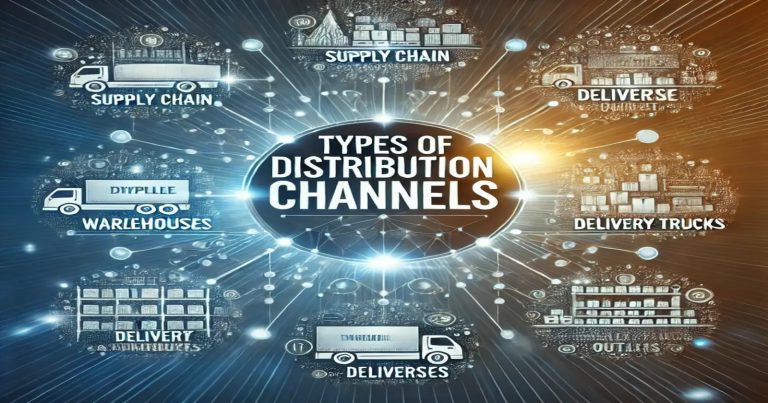Distribution channels are essential for manufacturers to make contact with customers. They are the routes by which goods and services flow to end-use customers, guaranteeing the availability of products where and when their customers want them. Distribution channels include direct and indirect channels through which business enterprises can transport their goods from the manufacturer to the final consumer. Through the learning types of distribution channels, firms can decide which approach access is appropriate for the kind of product, target customer, and what they aim to achieve. Whether a brand prioritizes fast delivery, cost-effectiveness, or broad market coverage, choosing the correct channel is essential for maximizing sales and customer satisfaction.
What is Distribution Channel?
A distribution channel is the process whereby a product or service flows from the manufacturer to the final consumer. It is a bridge that enables the exchange of products and services, making sure they are efficiently delivered as soon as possible.
For example, when a customer purchases a product in a box store or an online order, that product goes through a distribution channel.
Features:
- This channel may include manufacturers, wholesalers, retailers, and logistics participants, who may all be involved in delivering the product from its manufacturing place to its destination.
- Distribution channels play an essential role in the business strategy. They go far beyond transporting goods but contribute to creating value by delivering products to the right place, at the right moment, and in quantity.
- Companies select their channels based on the target audience, the cost structure of the company, and the operational abilities of the company so as to provide the customer with an unbroken experience.
Examples of Distribution Channel
Distribution channels can take many forms, depending on the industry, product type, and customer preferences. Each example demonstrates the variety of ways that firms get their customers.
- Direct-to-consumer (DTC) selling is the most basic distribution channel model, where firms sell directly to customers, bypassing any middlemen. For instance, a clothing brand might use its website or physical stores to reach its audience. Instead, indirect distribution relies on a mediatory role, such as through wholesalers or retailers. For example, a snack producer may sell and distribute products through supermarkets and convenience shops.
- E-commerce sites such as Amazon provide a contemporary illustration of distribution channels that link multi-millions of companies and customers worldwide. For example, service providers, like insurance companies, may depend on brokers or agents to offer their services to customers. Those cases represent the variety and variability of distribution channels, providing an idea of diversification and how companies could adjust their strategy depending on their requirements.
Types of Distribution Channels
Direct and indirect. These are then subdivided into subcategories according to the number of intermediaries accumulated in a solution and the strategy used by the company in business operations.
Direct Distribution Channels
Direct distribution channels sell the product directly to consumers without using intermediaries. This approach gives companies complete control over price, promotion and customer service. Companies that employ direct channels conduct business over their own retail locations, websites, or direct sales forces.
Examples: Companies such as Apple rely on direct distribution by selling products through their own branded stores or websites. That is, they have control over the entire customer journey, from purchase through post-sale service.
Benefits
- Direct distribution channels are beneficial for companies that manufacture high-value or specialist items and require to be close to customers.
- Direct channels are both economically efficient in the long run since they are no longer required to share profits with intermediaries such as agents.
- They, nevertheless, are challenging to scale, particularly businesses operating in several markets.
Indirect Distribution Channels
Indirect distribution channels involve one or more intermediaries who assist in moving products from the manufacturer to the consumer. These intermediaries include wholesalers, retailers, agents, and brokers. Indirect channels are widely used by businesses that need to distribute their products over a broad geographic area or want to focus primarily on production rather than sales and marketing.
Example
- Beverage manufacturers may utilize wholesalers to deliver their products from one region of the country to retailers in another. This makes it possible to increase market scope without providing direct logistical control.
- Indirect distribution channels are also led by retailers such as Walmart and Target, which allow manufacturers to deliver their products to a large clientele.
Benefits
- Indirect channels are highly effective, but this is not without the problems of lower control over the price and customer experience.
- Businesses need to choose trustworthy intermediaries to maintain their brand image.
Dual Distribution Channels
This combines the use of both direct and indirect methods. Firms like Samsung employ this system while selling through direct sources such as their online stores and retailers selling these products. This enhances customer access to the product but spreads out revenue generation channels.
Exclusive Channels
Exclusive distribution is where the products are sold to a few retailers or distributors. Luxury brands like Gucci and Tesla make use of exclusive distribution to keep the brand in the premium segment while offering personal service to customers. This model applies to luxury or unique products.
Levels of Distribution Channels
The number of intermediaries between a product and the consumer governs distribution channel levels. These channels are zero, one, two, and three-level channels, each fulfilling different business purposes.
Zero-Level Channels (Direct)
Zero-level channels involve no intermediaries. The producer sells to the direct consumer, which is typical in the case of e-commerce, mail-order stores or out-of-the-factory stores. To this degree, companies have complete control of the distribution process, but this could involve substantial investment in logistics and customer service technology.
One-Level Channels
Single-level channels consist of one intermediate, e.g., a retailer. Small businesses frequently rely on this approach for local or regional distribution of products. For instance, a bakery may sell directly to local grocery stores, which sell to consumers.
Two-Level Channels
Two-level channels have two middlemen, usually a wholesaler and a retailer. At this level, consumer products with high market penetration is typical. Wholesalers buy in bulk and sell en bloc to the retail level, who sell en bloc to end users.
Three-Level Channels
Three-level channels include three intermediaries, i.e., agents, wholesalers, and consumers. These channels are generally used by-products with long distribution chains, like imports.
Importance of Distribution Channels
Distribution channels are a cornerstone of business success. Not only do they guarantee the availability of products to consumers, but also, they add value to the entire supply chain.
- Companies can gain greater efficiency, lower costs, and higher customer satisfaction through appropriate distribution channels.
- Efficient distribution channels enable companies to open new markets and go to heterogeneous customer bases. They also provide a framework for scaling operations without overburdening internal resources.
- For example, a small company might adopt an indirect distribution channel into international markets using wholesalers’ and retailers’ knowledge about those areas.
- Another essential advantage of distribution channels is their capacity to optimize logistics. When a company outsources its transportation warehousing and inventory control to third parties, it can concentrate its efforts on essential core functions, such as product development and marketing.
- Time and money can be saved, but also a greater level of satisfaction than would typically be attainable just by using a traditional system of pretreated images to create a decision support system based on each patient.
Intensive vs Selective vs Exclusive Distribution
Companies adopt various distribution models depending on what they want to achieve, their target, and what they sell. The three main concepts are intensive, selective, and exclusive distribution.
| Aspect | Intensive Distribution | Selective Distribution | Exclusive Distribution |
| Definition | Distributes products across as many outlets as possible. | Works with a limited number of outlets to maintain control. | Limits product availability to a single distributor per region or market. |
| Objective | Maximize product availability and visibility. | Maintain control over brand image and pricing. | Create exclusivity and enhance brand value. |
| Product Type | Fast-moving consumer goods (e.g., snacks, beverages, personal care). | High-value or specialized goods (e.g., electronics, furniture). | Luxury items or high-end goods (e.g., designer apparel, luxury cars). |
| Examples | Products in supermarkets, convenience stores, and online platforms. | Electronics are sold through authorized dealers or retailers. | Luxury cars sold through exclusive dealerships. |
| Market Reach | Extremely wide reach and customer access. | Moderate reach, targeted to specific markets or regions. | Limited reach to specific regions or markets. |
| Advantages | High sales volume due to broad availability. | Better brand control and higher profit margins. | Enhanced brand image and premium customer experience. |
| Challenges | Requires significant investment in logistics and inventory management. | Requires careful selection of reliable partners. | Limited market reach and dependency on a single distributor. |
Types of Distribution Channels FAQs
What is distribution channel?
A distribution channel is the route of goods or services from a producer to the final consumer. It allows businesses to provide products effectively while also preserving customer satisfaction.
What are the 4 types of distribution channels?
The 4 principal channels are direct, indirect, dual, and reverse channels, respectively. Each has a different structure and is valid for different business purposes.
How do distribution channels affect marketing?
Distribution channels are central to marketing by providing the possibility of the product when and where the customer needs it. They also influence pricing, branding, and customer experience.
What are the levels of distribution channels?
Levels of distribution channels are denoted as zero-level (direct), one-level (with 1 intermediary), two-level (wholesaler-retailer), and three-level (agent-wholesaler-retailer) distribution channels.
What is the difference between selective and exclusive distribution?
Selective distribution uses a few outlets to maintain control over pricing and branding, while exclusive distribution involves a single distributor per region to create a premium experience.


